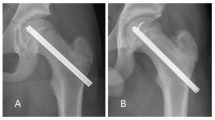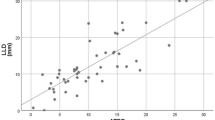Abstract
Purpose
To compare longitudinal growth and cam deformity of the proximal femur after treatment for slipped capital femoral epiphysis (SCFE) with one screw versus two smooth pins.
Methods
We studied 43 patients (29 males, 14 females; mean age, 12.1 years; range, 9.5–14 years) with idiopathic unilateral SCFE treated with in situ fixation with one cannulated screw (group A, n = 23) or two smooth pins (group B, n = 20). Anteroposterior and frog-leg radiographs of the pelvis were evaluated for each patient at initial presentation, post-operatively and at physeal closure. Longitudinal growth was evaluated using the femoral neck length (FNL), the caput–collum–diaphyseal (CCD) angle, and the articulo-trochanteric distance (ATD). Cam deformity was assessed using the anterior offset α-angle and the head–neck offset ratio (HNOR). The mean follow-up was 5.1 years (range, 4–7 years).
Results
Postoperatively, the mean CCD angle was 138.3°, the mean α-angle was 66.1° and the mean HNOR was − 0.030. At physeal closure, mean CCD angle significantly decreased to 133.6°, mean α-angle significantly reduced to 52.1°, and mean HNOR significantly improved to + 0.039. CCD, FNL, ATD, α-angle, and HNOR were not different between groups.
Conclusions
One screw or two smooth pins result in similar longitudinal growth and deformity of the proximal femur after SCFE. The femoral head–neck junction remarkably improves until physeal closure; however, residual cam deformity is not avoided after in situ pinning. The complication rate with smooth pins is higher.







Similar content being viewed by others
References
Loder RT, Dietz FR (2012) What is the best evidence for the treatment of slipped capital femoral epiphysis? J Pediatr Orthop 32(Suppl 2):S158–S165. https://doi.org/10.1097/BPO.0b013e318259f2d1
Kim SJ, Bloom T, Sabharwal S (2013) Leg length discrepancy in patients with slipped capital femoral epiphysis. Acta Orthop 84(3):271–274. https://doi.org/10.3109/17453674.2013.795103
Guzzanti V, Falciglia F, Stanitski CL (2004) Slipped capital femoral epiphysis in skeletally immature patients. J Bone Joint Surg (Br) 86(5):731–736. https://doi.org/10.1302/0301-620x.86b5.14397
Kumm DA, Lee SH, Hackenbroch MH, Rutt J (2001) Slipped capital femoral epiphysis: a prospective study of dynamic screw fixation. Clin Orthop Relat Res 384:198–207. https://doi.org/10.1097/00003086-200103000-00023
Lehmann TG, Engesaeter IO, Laborie LB, Rosendahl K, Lie SA, Engesaeter LB (2011) In situ fixation of slipped capital femoral epiphysis with Steinmann pins. Acta Orthop 82(3):333–338. https://doi.org/10.3109/17453674.2011.579520
Sailhan F, Courvoisier A, Brunet O, Chotel F, Berard J (2011) Continued growth of the hip after fixation of slipped capital femoral epiphysis using a single cannulated screw with a proximal threading. J Child Orthop 5(2):83–88. https://doi.org/10.1007/s11832-010-0324-0
Seller K, Wild A, Westhoff B, Raab P, Krauspe R (2006) Radiological evaluation of unstable (acute) slipped capital femoral epiphysis treated by pinning with Kirschner wires. J Pediatr Orthop B 15(5):328–334. https://doi.org/10.1097/01202412-200609000-00005
Holmdahl P, Backteman T, Danielsson A, Karrholm J, Riad J (2016) Continued growth after fixation of slipped capital femoral epiphysis. J Child Orthop 10(6):643–650. https://doi.org/10.1007/s11832-016-0793-x
Blanco JS, Taylor B, Johnston CE 2nd (1992) Comparison of single pin versus multiple pin fixation in treatment of slipped capital femoral epiphysis. J Pediatr Orthop 12(3):384–389. https://doi.org/10.1097/01241398-199205000-00019
Aronsson DD, Loder RT, Breur GJ, Weinstein SL (2006) Slipped capital femoral epiphysis: current concepts. J Am Acad Orthop Surg 14(12):666–679. https://doi.org/10.5435/00124635-200611000-00010
Loder RT, Richards BS, Shapiro PS, Reznick LR, Aronson DD (1993) Acute slipped capital femoral epiphysis: the importance of physeal stability. J Bone Joint Surg Am 75(8):1134–1140. https://doi.org/10.2106/00004623-199308000-00002
Southwick WO (1967) Osteotomy through the lesser trochanter for slipped capital femoral epiphysis. J Bone Joint Surg Am 49(5):807–835. https://doi.org/10.2106/00004623-196749050-00001
Rao SB, Crawford AH, Burger RR, Roy DR (1996) Open bone peg epiphysiodesis for slipped capital femoral epiphysis. J Pediatr Orthop 16(1):37–48. https://doi.org/10.1097/00004694-199601000-00008
Müller ME (1957) Die hüftnahen Femurosteotomien under Berücksichtigung der Form, Funktion und Beanspruchung des Hüftgelenkes. Thieme, Stuttgart
Edgren W (1965) Coxa plana. A clinical and radiological investigation with particular reference to the importance of the metaphyseal changes for the final shape of the proximal part of the femur. Acta Orthop Scand 36(Suppl 84):3–129. https://doi.org/10.3109/ort.1965.36.suppl-84.01
Notzli HP, Wyss TF, Stoecklin CH, Schmid MR, Treiber K, Hodler J (2002) The contour of the femoral head-neck junction as a predictor for the risk of anterior impingement. J Bone Joint Surg (Br) 84(4):556–560. https://doi.org/10.1302/0301-620x.84b4.0840556
Clohisy JC, Nunley RM, Otto RJ, Schoenecker PL (2007) The frog-leg lateral radiograph accurately visualized hip cam impingement abnormalities. Clin Orthop Relat Res 462:115–121. https://doi.org/10.1097/blo.0b013e3180f60b53
Clohisy JC, Carlisle JC, Beaule PE, Kim YJ, Trousdale RT, Sierra RJ, Leunig M, Schoenecker PL, Millis MB (2008) A systematic approach to the plain radiographic evaluation of the young adult hip. J Bone Joint Surg Am 90(Suppl 4):47–66. https://doi.org/10.2106/jbjs.h.00756
Montgomery AA, Graham A, Evans PH, Fahey T (2002) Inter-rater agreement in the scoring of abstracts submitted to a primary care research conference. BMC Health Serv Res 2(1):8. https://doi.org/10.1186/1472-6963-2-8
Breaud J, Rubio A, Leroux J, Griffet J (2009) Residual hip growth after pinning of slipped capital femoral epiphysis. J Pediatr Orthop B 18(1):7–9. https://doi.org/10.1097/bpb.0b013e3283157ee0
Druschel C, Placzek R, Funk JF (2013) Growth and deformity after in situ fixation of slipped capital femoral epiphysis. Z Orthop Unfall 151(4):371–379. https://doi.org/10.1055/s-0033-1350667
Akiyama M, Nakashima Y, Kitano T, Nakamura T, Takamura K, Kohno Y, Yamamoto T, Motomura G, Ohishi M, Hamai S, Iwamoto Y (2013) Remodelling of femoral head-neck junction in slipped capital femoral epiphysis: a multicentre study. Int Orthop 37(12):2331–2336. https://doi.org/10.1007/s00264-013-2047-6
Castaneda P, Ponce C, Villareal G, Vidal C (2013) The natural history of osteoarthritis after a slipped capital femoral epiphysis/the pistol grip deformity. J Pediatr Orthop 33(Suppl 1):S76–S82. https://doi.org/10.1097/bpo.0b013e318277174c
Fraitzl CR, Kafer W, Nelitz M, Reichel H (2007) Radiological evidence of femoroacetabular impingement in mild slipped capital femoral epiphysis: a mean follow-up of 14.4 years after pinning in situ. J Bone Joint Surg (Br) 89-B(12):1592–1596. https://doi.org/10.1302/0301-620x.89b12.19637
Author information
Authors and Affiliations
Corresponding author
Ethics declarations
Conflict of interest
The authors declare that they have no conflict of interest. No benefits have been or will be received from a commercial party related directed or indirectly to the subject matter of this article.
Ethical approval
This article does not contain any studies with human participants or animals performed by any of the authors.
Informed consent
Informed consent was obtained from all individual participants included in the study.
Rights and permissions
About this article
Cite this article
Megaloikonomos, P.D., Mavrogenis, A.F., Panagopoulos, G.N. et al. Similar femoral growth and deformity with one screw versus two smooth pins for slipped capital femoral epiphysis. International Orthopaedics (SICOT) 43, 1627–1634 (2019). https://doi.org/10.1007/s00264-018-4058-9
Received:
Accepted:
Published:
Issue Date:
DOI: https://doi.org/10.1007/s00264-018-4058-9




